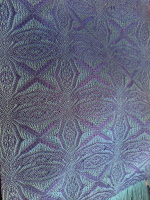 |
| Phyllis at her loom |
Prior to the Bonts arrival, the physician serving the
Cavendish/Proctorsville area died. Two fatal car accidents occurred and
Cavendish found they could not rely on Ludlow for medical coverage. Community
leaders meet with the University of Vermont Medical School and were advised to equip a medical office and then recruit a physician.
Kenwood Mills, who purchased Gay Brothers Mills and its holdings in 1951,
donated the stone building to help form the new BRHC. Phyllis was attracted to Cavendish because members of the community donated
their time to renovate the building and workers at Kenwood Mills had $1 a week
withheld from their pay to help create the medical facility.
 |
| Black River Health Center |
In addition to raising seven children, Phyllis was involved
in numerous community activities along with being a visiting nurse. In the
1970s, it was agreed at a family meeting that Phyllis would enroll at the
University of Vermont’s in what would be their third graduating class of nurse
practitioners (RNPs). For a year and a half, Phyllis worked Monday and Tuesday for the
Visiting Nurses and from Tuesday night to Friday night she would attend class
in Burlington. Some of her clinical experiences were at the BRHC, where Gene
had recognized the critical need for physician assistants (PAs) and RNPs in the delivery of health care in rural areas.
“I wanted to do a better job as a visiting nurse,” Phyllis
gave as her reason for returning to school. However, once she had received her
RNP, she found that she became frustrated when doctors did not acknowledge her
ability to diagnosis patients. Given that Gene had been
using PAs for quite some time, she joined the BRHC, where she worked until
1988, when they relocated to Albany Medical Center (AMC).
AMC offered its own set of rewarding experiences and challenges.
Phyllis not only worked on the front lines of the AIDS epidemic, but she also
expanded her role in the Family Medicine Department to include being a teacher
and preceptor. Because the Bonts still called Cavendish home, they would return
on weekends. Phyllis volunteered her time, and even her home, to those affected
by HIV/AIDS in Vermont and New Hampshire.
When Gene and Phyllis decided to retire, they returned to
Cavendish after having spent 11 years in Albany. Phyllis was quite adamant that
she didn’t want to spend her retirement cleaning the large house, nor was she
interested in being a nurse. In addition to spending time with her children and
grandchildren, she returned to a childhood passion-weaving.
 |
| Phyllis's favorite pattern that she has woven. |
Phyllis thanks her 4th grade practical arts teacher for
allowing her to make use of a loom from grades 4-6. After that she didn’t have
an opportunity to weave again until the 1970s, when she took classes in
Charlestown. However, it was when she hung up her stethoscope and started
collecting fibers that another whole career took off.
One of the original founders of Six Loose Ladies, Phyllis
not only helped to staff the store, that for many years was on the corner of
Depot Street and Route 131, but she taught weaving and sold her incredible shawls,
scarves and other items.
 |
| One of Phyllis's shawls |
Phyllis continues her career as a healer through fiber
arts. The gorgeous shawls and scarves
she makes is her way to continually wrap someone in loving-kindness. Her
shawls, in particular, come with a note about wrapping it around you when you need
a hug.
In the series Cavendish
Women You Should Know, Phyllis knew all of the women being featured and her
memories of them will appear in upcoming posts.
Listen to an interview of Phyllis on Vermont Public Radio.

The day I left school to go take care of my dying parents Gene and Phyllis came into my classroom with a beautiful scarf. I wore it often during the next few weeks finding solace. It is a hug and I cherish it.
ReplyDelete